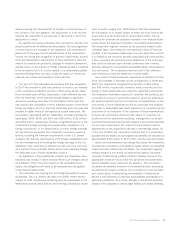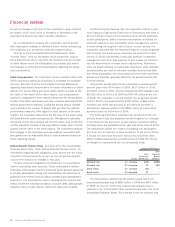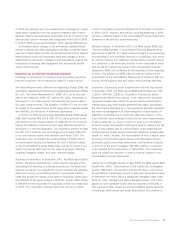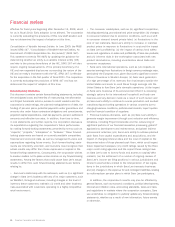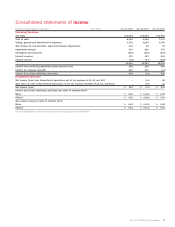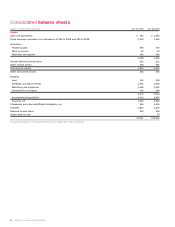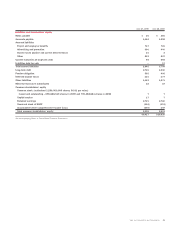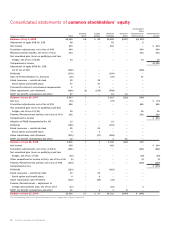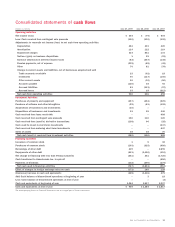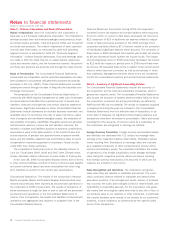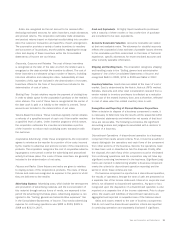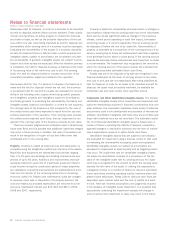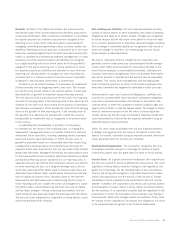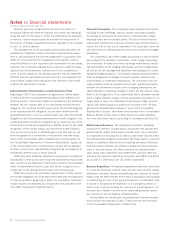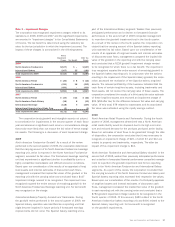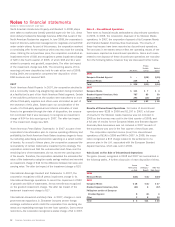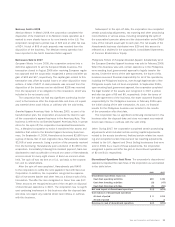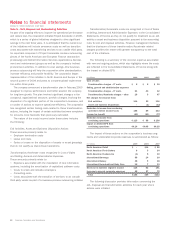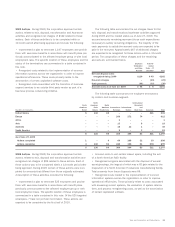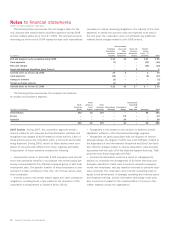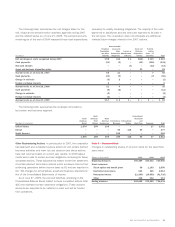Sara Lee 2009 Annual Report Download - page 55
Download and view the complete annual report
Please find page 55 of the 2009 Sara Lee annual report below. You can navigate through the pages in the report by either clicking on the pages listed below, or by using the keyword search tool below to find specific information within the annual report.Sales are recognized as the net amount to be received after
deducting estimated amounts for sales incentives, trade allowances
and product returns. The corporation estimates trade allowances
and product returns based on historical results taking into consider-
ation the customer, transaction and specifics of each arrangement.
The corporation provides a variety of sales incentives to resellers
and consumers of its products, and the policies regarding the recog-
nition and display of these incentives within the Consolidated
Statements of Income are as follows:
Discounts, Coupons and Rebates
The cost of these incentives
is recognized at the later of the date at which the related sale is
recognized or the date at which the incentive is offered. The cost of
these incentives is estimated using a number of factors, including
historical utilization and redemption rates. Substantially all cash
incentives of this type are included in the determination of net sales.
Incentives offered in the form of free product are included in the
determination of cost of sales.
Slotting Fees
Certain retailers require the payment of slotting fees
in order to obtain space for the corporation’s products on the retailer’s
store shelves. The cost of these fees is recognized at the earlier of
the date cash is paid or a liability to the retailer is created. These
amounts are included in the determination of net sales.
Volume-Based Incentives
These incentives typically involve rebates
or refunds of a specified amount of cash only if the reseller reaches
a specified level of sales. Under incentive programs of this nature,
the corporation estimates the incentive and allocates a portion
of the incentive to reduce each underlying sales transaction with
the customer.
Cooperative Advertising
Under these arrangements, the corporation
agrees to reimburse the reseller for a portion of the costs incurred
by the reseller to advertise and promote certain of the corporation’s
products. The corporation recognizes the cost of cooperative advertis-
ing programs in the period in which the advertising and promotional
activity first takes place. The costs of these incentives are generally
included in the determination of net sales.
Fixtures and Racks
Store fixtures and racks are given to retailers
to display certain of the corporation’s products. The costs of these
fixtures and racks are recognized as expense in the period in which
they are delivered to the retailer.
Advertising Expense Advertising costs, which include the development
and production of advertising materials and the communication of
this material through various forms of media, are expensed in the
period the advertising first takes place. Advertising expense is rec-
ognized in the “Selling, general and administrative expenses” line
in the Consolidated Statements of Income. Total media advertising
expense for continuing operations was $282 in 2009, $325 in
2008 and $313 in 2007.
Cash and Equivalents All highly liquid investments purchased
with a maturity of three months or less at the time of purchase
are considered to be cash equivalents.
Accounts Receivable Valuation Accounts receivable are stated
at their net realizable value. The allowance for doubtful accounts
reflects the corporation’s best estimate of probable losses inherent
in the receivables portfolio determined on the basis of historical
experience, specific allowances for known troubled accounts and
other currently available information.
Shipping and Handling Costs The corporation recognizes shipping
and handling costs in the “Selling, general and administrative
expenses” line of the Consolidated Statements of Income and
recognized $693 in 2009, $703 in 2008 and $656 in 2007.
Inventory Valuation Inventories are stated at the lower of cost or
market. Cost is determined by the first-in, first-out (FIFO) method.
Rebates, discounts and other cash consideration received from a
vendor related to inventory purchases is reflected as a reduction
in the cost of the related inventory item, and is therefore, reflected
in cost of sales when the related inventory item is sold.
Recognition and Reporting of Planned Business Dispositions
When a decision to dispose of a business component is made, it
is necessary to determine how the results will be presented within
the financial statements and whether the net assets of that busi-
ness are recoverable. The following summarizes the significant
accounting policies and judgments associated with a decision to
dispose of a business.
Discontinued Operations
A discontinued operation is a business
component that meets several criteria. First, it must be possible to
clearly distinguish the operations and cash flows of the component
from other portions of the business. Second, the operations need
to have been sold or classified as held for disposal. Finally, after
the disposal, the cash flows of the component must be eliminated
from continuing operations and the corporation may not have any
significant continuing involvement in the business. Significant judg-
ments are involved in determining whether a business component
meets the criteria for discontinued operation reporting and the
period in which these criteria are met.
If a business component is reported as a discontinued operation,
the results of operations through the date of sale are presented on
a separate line of the income statement. Interest on corporate level
debt is not allocated to discontinued operations. Any gain or loss
recognized upon the disposition of a discontinued operation is also
reported on a separate line of the income statement. Prior to dispo-
sition, the assets and liabilities of discontinued operations are
aggregated and reported on separate lines of the balance sheet.
Gains and losses related to the sale of business components
that do not meet the discontinued operation criteria are reported
in continuing operations and separately disclosed if significant.
Sara Lee Corporation and Subsidiaries 53


